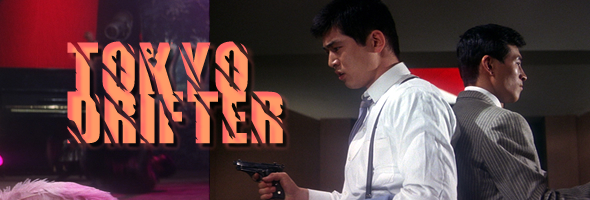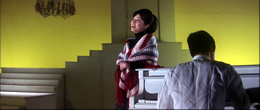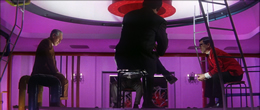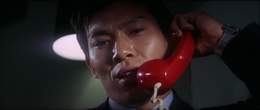
Color, 1966, 83m.
Directed by Seijun Suzuki
Starring Tetsuya Watari, Hideaki Nitani, Chieko Matsubara, Ryûji Kita, Tamio Kawaji, Eiji Go
Criterion (Blu-Ray & DVD) (US RA/R1 HD) / WS (2.35:1) (16:9)

Color, 1966, 83m.
Directed by Seijun Suzuki
Starring Tetsuya Watari, Hideaki Nitani, Chieko Matsubara, Ryûji Kita, Tamio Kawaji, Eiji Go
Criterion (Blu-Ray & DVD) (US RA/R1 HD) / WS (2.35:1) (16:9)
 In its rapturous original liner notes, Criterion described Tokyo Drifter (Tokyo Nagaremono) as equal parts Russ Meyer, Samuel Fuller, and Nagisa Oshima, with packaging clearly designed to target the growing American audience primed for Japanese and Hong Kong cinema thanks to the efforts of John Woo, Quentin Tarantino, et al. However, viewers expecting a slam bang visceral ballet of nonstop gunplay and sex were instead handed a visual study of alienation in a candy-colored Tokyo gone mad, much closer to deliberately paced '60s Japanese camp like Black Lizard than Hard Boiled. Along with fellow late '90s Criterion partner Branded to Kill (also from director Seijun Suzuki), this film proved pivotal in introducing new generations of English-speaking movie buffs to the
In its rapturous original liner notes, Criterion described Tokyo Drifter (Tokyo Nagaremono) as equal parts Russ Meyer, Samuel Fuller, and Nagisa Oshima, with packaging clearly designed to target the growing American audience primed for Japanese and Hong Kong cinema thanks to the efforts of John Woo, Quentin Tarantino, et al. However, viewers expecting a slam bang visceral ballet of nonstop gunplay and sex were instead handed a visual study of alienation in a candy-colored Tokyo gone mad, much closer to deliberately paced '60s Japanese camp like Black Lizard than Hard Boiled. Along with fellow late '90s Criterion partner Branded to Kill (also from director Seijun Suzuki), this film proved pivotal in introducing new generations of English-speaking movie buffs to the  extreme pleasures of Japanese crime films, paving the way for rediscovery of dozens of other filmmakers like Fukasaku and Yasuharu Hasebe.
extreme pleasures of Japanese crime films, paving the way for rediscovery of dozens of other filmmakers like Fukasaku and Yasuharu Hasebe.
"Phoenix" Tetsu (Watari), a killer for hire, decides to go straight and follow the example set by his seemingly conscience-stricken boss. Unfortunately he finds himself drifting around the deserted areas of Tokyo, both eluding and awaiting a certain death at the hands of the villainous Viper (Kawaji) but returning for the company of his nightclub singer girlfriend (Matsubara). The gunfights are staged with detached elegance and precise editing that foreshadows many of the ironic showdowns popularized in modern action cinema, in much the same manner as Jean-Pierre Melville's similar output in France during the same period. The first half hour is extremely static and narratively meandering at times, but it picks up soon enough and snaps into sharp focus once the story kicks into gear. Mostly, though, this is a work of sublime artifice, from Watari's wounded dog and sunglasses demeanor to Matsubara's pastel-colored nightclub setpieces which now look like a cross between MGM and Shaw Brothers musicals.
which now look like a cross between MGM and Shaw Brothers musicals.
While the film was shot in full 2.35:1 scope, Criterion's first non-anamorphic transfer for laserdisc and a 1999 DVD was squeezed out enough to give the characters' heads an irritating oblong appearance. Also, it didn't remotely live up to the box's hyperbolic claims of "a lush color transfer from the original, glorious Nikkatsu-scope master." The colors were actually pretty dull and washed out most of the time, with far too much contrast in the skin tones. The English subtitles were optional, allowing you to gawk at some of the more outlandish camera setups without the impediment of words plastered across the screen. Manohla Dargis' generally informative liner notes referred to the opening sequence (presented in black and white in this print) as being "tinted a bilious green," which makes one wonder about the condition of the print she watched. The opening is supposed to be monochrome, with deliberately extreme contrast and graininess to give it a roughed-up texture. The DVD also included an endearing interview with Suzuki in which he describes his maverick filmmaking decisions, which eventually led to his banishment from the Japanese movie studio system.
Of all of Criterion's releases in the dawning days of DVD, this one needed an upgrade more than any other. Finally salvation arrived courtesy of their 2011 HD upgrade to Blu-Ray, with a remastered DVD reissue as well. The Blu-Ray is definitely the preferred option though as it finally conveys the candy-colored intensity of the film's original color schemes, with an eye-popping array of hues in the art direction ranging from lavendar and ochre walls to cherry-colored telephones. The original framing has also been mercifully restored, and the entire experience is much easier and more enjoyable to sit through with all of these original aesthetic elements finally restored. The original Suzuki interview is carried over, while a new one with him and assistant director Masami Kuzuu is also included with more details about their Nikkatsu days, the casting process, and the logistics of mounting pop art sets in a limited time period. The original trailer is also included along with a liner notes booklet which replaces the original notes with new ones by critic Howard Hampton, who rattles off seven of the film's key moments and puts it in context with the spy and crime film craze of the era. Definitely a welcome improvement in every department.
![]()